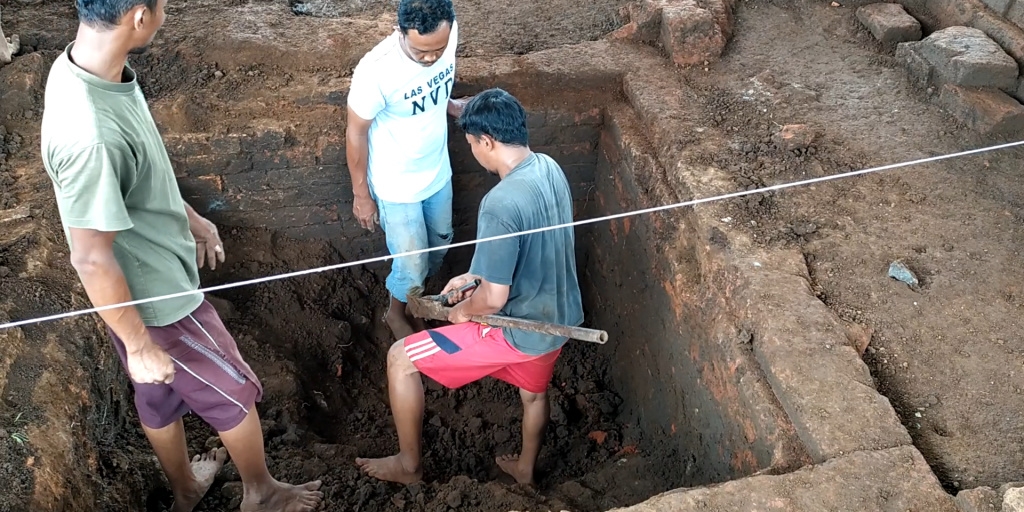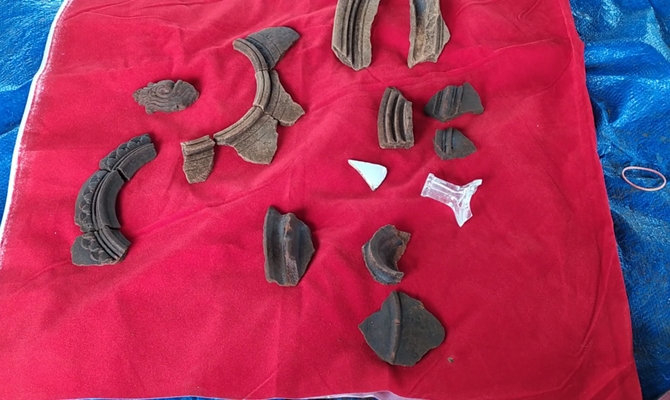Viral Angkot Driver Carrying 3-Month-Old Baby While Working, Wife Dies-Child Breathes Vehicle Smoke Every Day
This story suddenly went viral and made many people sad.

Kapanlagi.com - The excavation of the Pendem site in Kota Batu found a well located in the middle of a building. The well, measuring 2.1 meters by 2.1 meters, is situated in the middle of a temple building and its depth is still being excavated.
Wicaksono Dwi Nugroho, an archaeologist and the head of the excavation team from the Trowulan Cultural Heritage Preservation Agency in East Java, stated that the team was able to reveal the extent of the temple, which measures 7.5 meters by 7.5 meters. Meanwhile, a well was found in the middle of the temple.
"Through this excavation, we were able to reveal the shape of a building measuring 7.5 meters by 7.5 meters. We also discovered a well in the middle of the temple, measuring 2.1 meters by 2.1 meters," said Wicaksono Dwi Nugroho in Pendem Village, Junrejo District, Kota Batu, on Monday (17/2).
According to Wicaksono, the discovery of the well confirms that the building is indeed a temple. Its orientation towards the east indicates that the temple was a place of worship, as evidenced by the nearby discovery of a nandi statue and yoni symbol.
"This finding strengthens the idea that this is a temple building associated with the discovery of the yoni and nandi statue not far from the location," he emphasized.

© KapanLagi.com/Darmadi Sasongko
The site, according to Wicaksono, is believed to be a 10th century relic of ancient Mataram, referring to the Sanguran Inscription. Therefore, the discovery is considered very significant for the history of Batu City, although further historical studies are still needed.
"Because so far we have been looking for temple findings in Batu City. Batu City itself is associated with the Sanguran Inscription from the 10th century AD. The location of the discovery (Sanguran Inscription) is not far from this site. According to the Dutch records (Ver Berg), it was found in the village of Ngandat (Junrejo)," he explained.
Archaeological evidence indicates that the entrance faces east, indicating that the site is a place of worship and not a place of worship. Meanwhile, the dimensions of the stones are larger than those previously found in the Trowulan and Sekaran (Tol Malang) sites.
The Pendem site has stone dimensions of 35 X 26 X 9-10 cm, while the Sekaran site measures 33 X 25 X 8 cm. The Sekaran site is also supported by the findings of coins and ceramics from the Song Dynasty, which is also around the 10th-11th centuries.
"It is possible that the Pendem site is even older, from the 10th century. This also indicates its connection to the Sanguran Inscription from the 10th century, which indicates the importance of Batu City during the era of Ancient Mataram," he said.
"If it is even older, it makes sense. Because not far from here, the Sanguran Inscription (928 AD) was found," he added.

© KapanLagi.com/Darmadi Sasongko
If it is true according to the Sanguran inscription, the temple was built for the iron workers in Batu City who made heirlooms for Ancient Mataram. In addition, the location of the pendem site, which is located on the edge of the river, confirms that the place is a source of iron ore.
The Sanguran inscription itself is located in Scotland, because at that time it was given as a gift by Governor Rafles to his friend, a general. The inscription in ancient Javanese language contains the inauguration of Sanguran Village as a sima land by Sri Maharaja Rakai Pangkaja, Dyah Wawa Sri Wijayaloka Namestungga on 14 Suklapaksa, Month of Srawana, Year 850 Saka or August 2, 928 AD.

© KapanLagi.com/Darmadi Sasongko
During the excavation process, Dutch coins from the Dutch East Indies in 1825 and Java coins from 1801 were also found. Fragments of pottery and European-style bottles were also found, indicating that the site was still existing on the surface of the ground in the 1800s.
"The mass is still visible, but it was demolished and destroyed, then buried by many stones found in the Sumuran hole. There may have been a change in beliefs at that time," he explained.
Meanwhile, in the Sumuran hole, river stones were found in quantities of more than one truck. The Sumuran hole itself is believed to be a balance between the earth's energy and the sky's energy in the Hindu Syiwa belief.
"This (burial) becomes a memory of the community, the event is known as the burial that became the name of the village. We know the name of this village because there is something buried, namely this temple," he said firmly.
In addition, the outer temple fence is still found, so it is suspected that the building is a complex with various complementary buildings. The community also often finds bricks of the same size found in the west and east at a distance of about 6 meters.
(kpl/dar/nda)
Cobain For You Page (FYP) Yang kamu suka ada di sini,
lihat isinya
This story suddenly went viral and made many people sad.
Ganjar Pranowo immediately took action when he received a complaint from netizens regarding a student who was a victim of bullying at SMP Muhammadiyah Butuh, Purworejo, Central Java.
It is known that this online motorcycle taxi driver was unlucky because he got a passenger who defecated on his motorcycle seat.
Two individuals have been designated as suspects in a bullying case in Malang. The two suspects, with the initials WS and RK, are school friends of the victim who are suspected of committing acts of violence while playing.
Toddlers in Malang Regency are suspected to have been swept away by rainwater in front of their house. Rafa Alfarisi (3.5) only left an umbrella at the scene, while the victim has not been found until now.
The investigators of Malang Kota Police are still waiting for the visum results from the hospital where the bullying victim is undergoing treatment. Read more here!
The handling process for bullying victims is still ongoing. This time, the victim is known to still be traumatized. Read more here!
A video of a teacher receiving a motorcycle and new shoes as gifts has gone viral on social media. Panji Setiaji, a contract teacher from Sukabumi, had to continue wearing his torn shoes for several months while teaching.
Bowo Alpenliebe admitted that he has never been paid by Tik Tok.
According to Iis Dahlia, netizens have misunderstood Salshadilla Juwita's statement.
Warteg Warmo is one of the legendary wartegs in Jakarta. Especially since it has been open since 1969. What is its secret, you ask?
This person once went viral with her video while dancing to the song Berharap Tak Berpisah by Reza Artamevia. Let's find out more about Sintya!